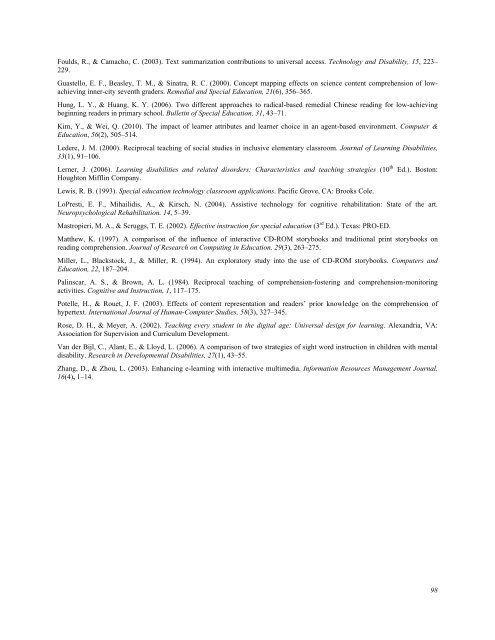October 2011 Volume 14 Number 4 - Educational Technology ...
October 2011 Volume 14 Number 4 - Educational Technology ...
October 2011 Volume 14 Number 4 - Educational Technology ...
Create successful ePaper yourself
Turn your PDF publications into a flip-book with our unique Google optimized e-Paper software.
Foulds, R., & Camacho, C. (2003). Text summarization contributions to universal access. <strong>Technology</strong> and Disability, 15, 223–<br />
229.<br />
Guastello, E. F., Beasley, T. M., & Sinatra, R. C. (2000). Concept mapping effects on science content comprehension of lowachieving<br />
inner-city seventh graders. Remedial and Special Education, 21(6), 356–365.<br />
Hung, L. Y., & Huang, K. Y. (2006). Two different approaches to radical-based remedial Chinese reading for low-achieving<br />
beginning readers in primary school. Bulletin of Special Education, 31, 43–71.<br />
Kim, Y., & Wei, Q. (2010). The impact of learner attributes and learner choice in an agent-based environment. Computer &<br />
Education, 56(2), 505–5<strong>14</strong>.<br />
Ledere, J. M. (2000). Reciprocal teaching of social studies in inclusive elementary classroom. Journal of Learning Disabilities,<br />
33(1), 91–106.<br />
Lerner, J. (2006). Learning disabilities and related disorders: Characteristics and teaching strategies (10 th Ed.). Boston:<br />
Houghton Mifflin Company.<br />
Lewis, R. B. (1993). Special education technology classroom applications. Pacific Grove, CA: Brooks Cole.<br />
LoPresti, E. F., Mihailidis, A., & Kirsch, N. (2004). Assistive technology for cognitive rehabilitation: State of the art.<br />
Neuropsychological Rehabilitation. <strong>14</strong>, 5–39.<br />
Mastropieri, M. A., & Scruggs, T. E. (2002). Effective instruction for special education (3 rd Ed.). Texas: PRO-ED.<br />
Matthew, K. (1997). A comparison of the influence of interactive CD-ROM storybooks and traditional print storybooks on<br />
reading comprehension. Journal of Research on Computing in Education, 29(3), 263–275.<br />
Miller, L., Blackstock, J., & Miller, R. (1994). An exploratory study into the use of CD-ROM storybooks. Computers and<br />
Education, 22, 187–204.<br />
Palinscar, A. S., & Brown, A. L. (1984). Reciprocal teaching of comprehension-fostering and comprehension-monitoring<br />
activities. Cognitive and Instruction, 1, 117–175.<br />
Potelle, H., & Rouet, J. F. (2003). Effects of content representation and readers’ prior knowledge on the comprehension of<br />
hypertext. International Journal of Human-Computer Studies, 58(3), 327–345.<br />
Rose, D. H., & Meyer, A. (2002). Teaching every student in the digital age: Universal design for learning. Alexandria, VA:<br />
Association for Supervision and Curriculum Development.<br />
Van der Bijl, C., Alant, E., & Lloyd, L. (2006). A comparison of two strategies of sight word instruction in children with mental<br />
disability. Research in Developmental Disabilities, 27(1), 43–55.<br />
Zhang, D., & Zhou, L. (2003). Enhancing e-learning with interactive multimedia. Information Resources Management Journal,<br />
16(4), 1–<strong>14</strong>.<br />
98

















